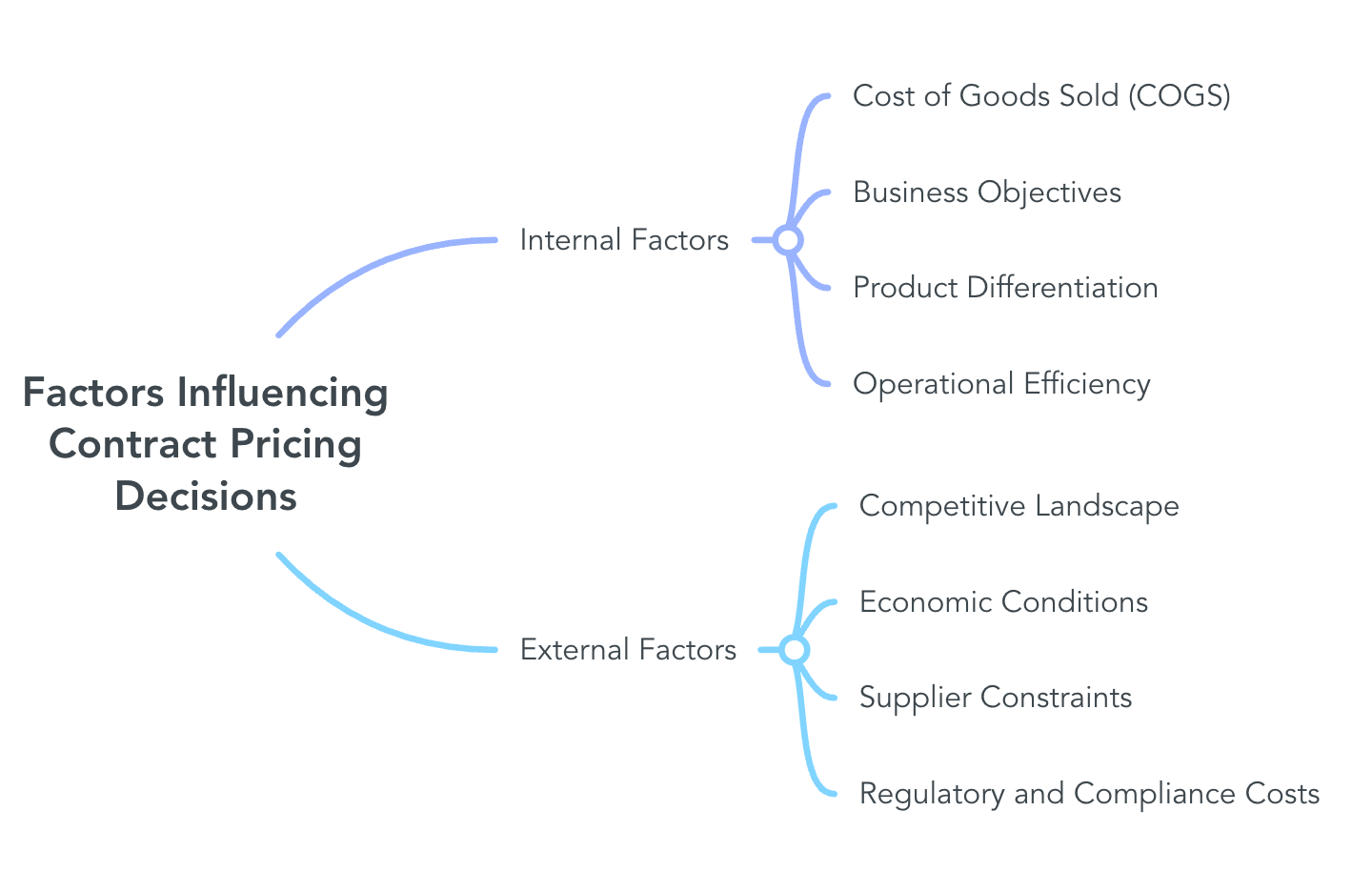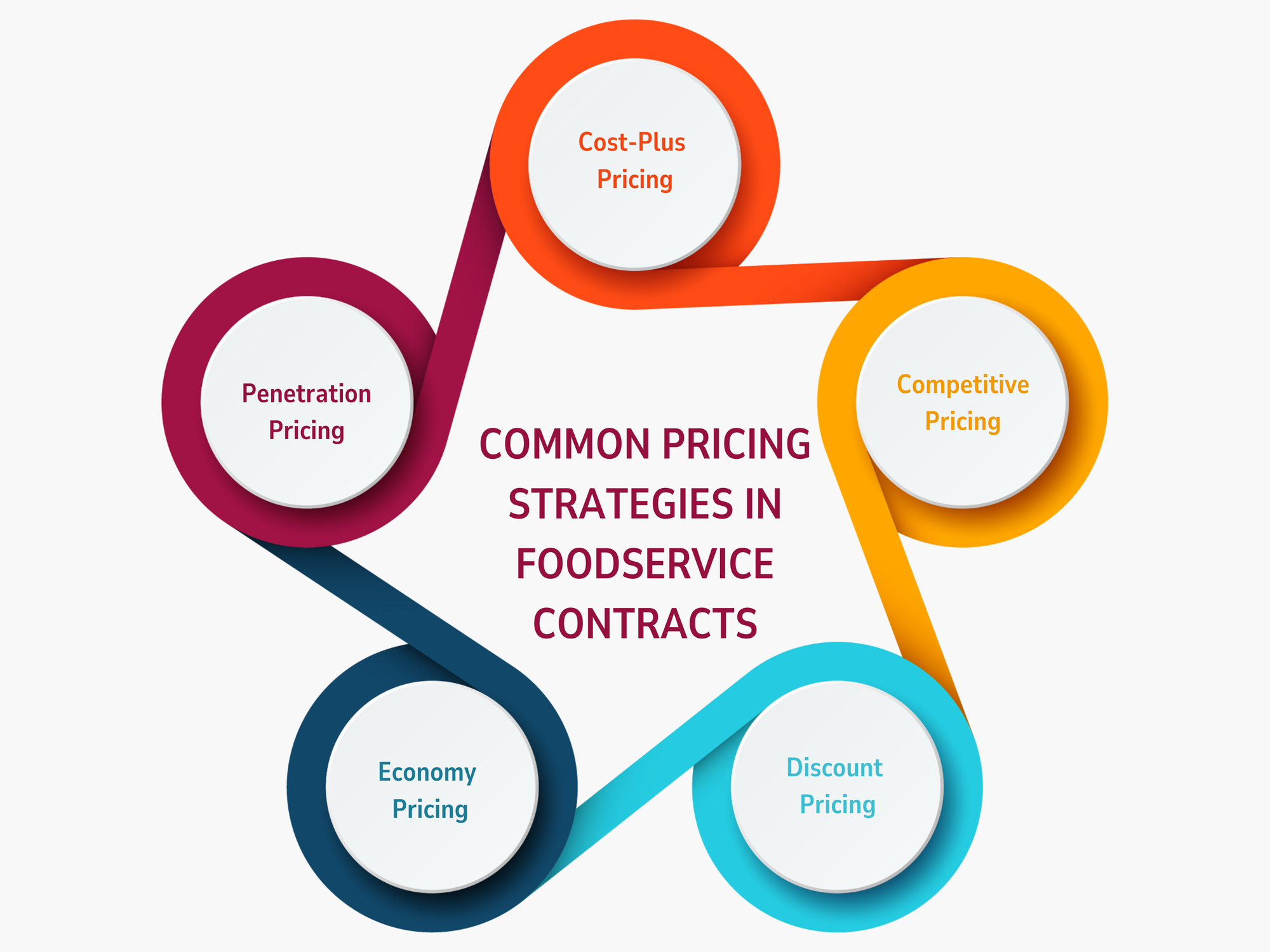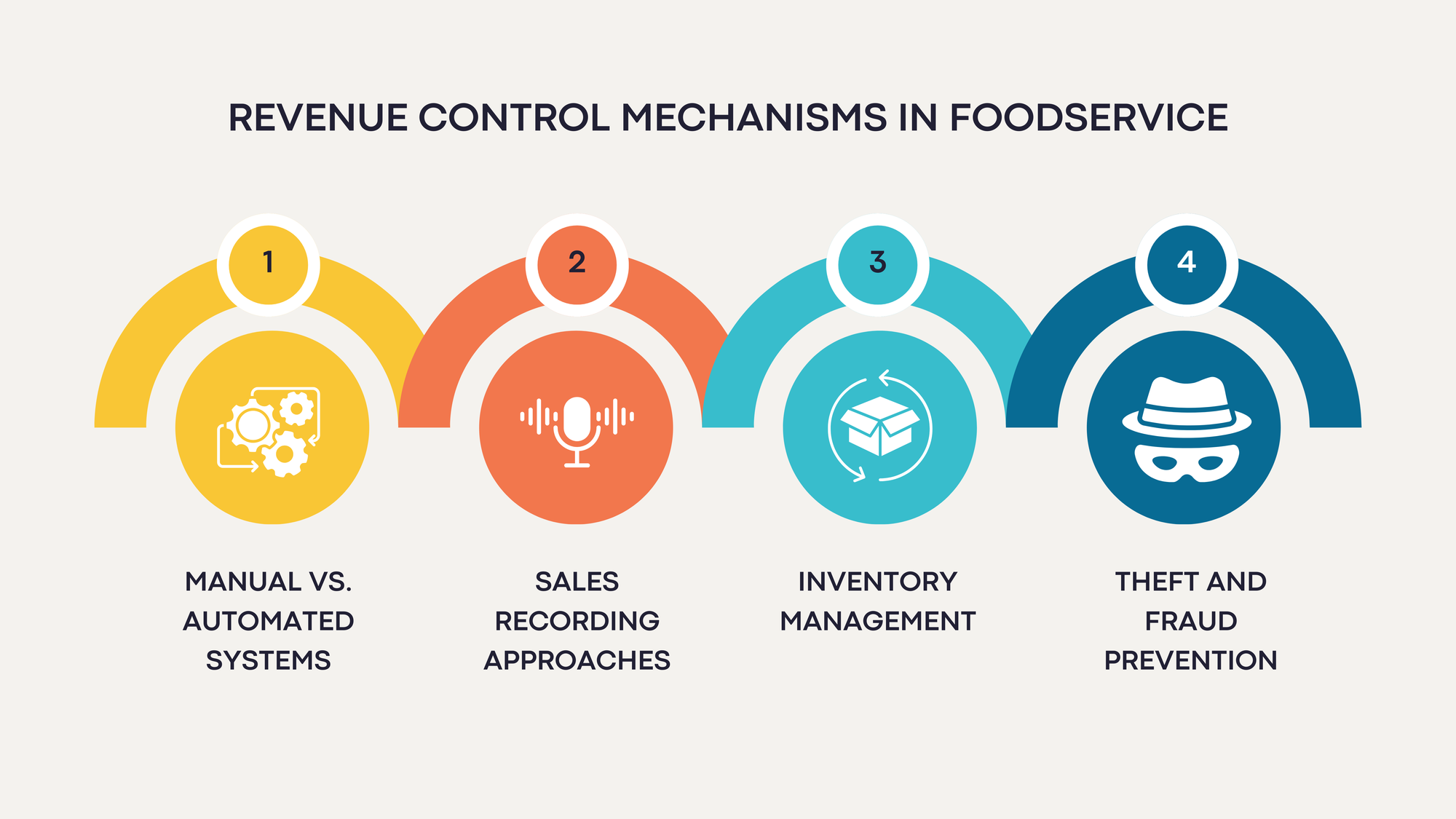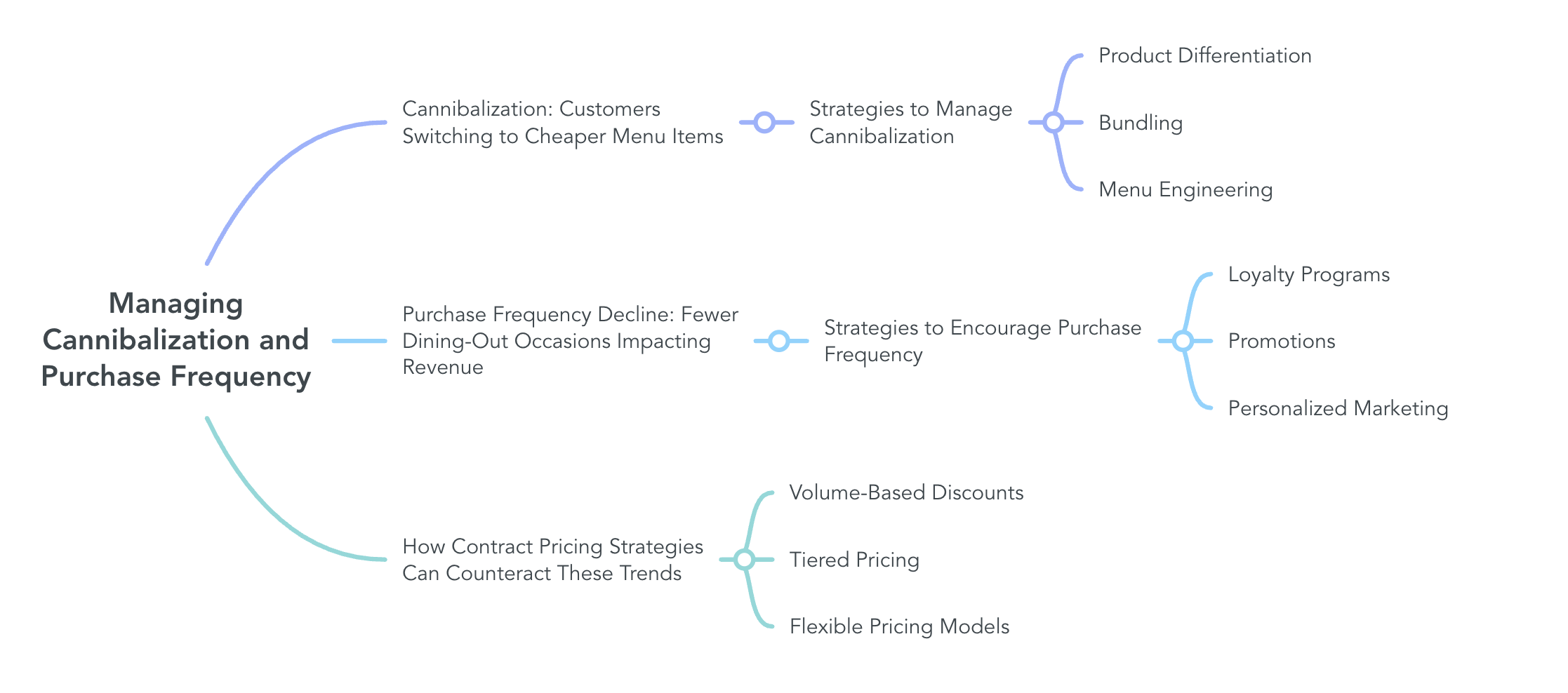Complete Guide to Contract Pricing Strategies and Revenue Control in Foodservice

The foodservice industry operates in a complex environment where contract pricing and revenue management play a critical role in financial stability. With economic pressures, fluctuating ingredient costs, and evolving consumer behaviors, businesses must adopt strategic pricing models to maintain profitability. Without proper revenue control mechanisms, companies risk margin erosion and revenue leakage, impacting long-term growth. Understanding different pricing strategies, managing contract terms effectively, and implementing technological solutions can help businesses navigate these challenges successfully. This guide provides an in-depth look at contract pricing strategies and revenue control in foodservice.
Table of Contents:
- What is Contract Pricing in Foodservice?
- Significance of Contract Pricing
- Key Components of a Foodservice Contract
- Factors Influencing Contract Pricing Decisions
- Consumer Behavior and Market Trends
- Common Pricing Strategies in Foodservice Contracts
- Revenue Control Mechanisms in Foodservice
- Managing Cannibalization and Purchase Frequency
- Preventing Revenue Leakage and Margin Erosion
- Challenges in Pricing and Revenue Management
- The Role of Technology in Modern Revenue Control
- Best Practices for Contract Pricing and Revenue Management
Jump to a section that interests you, or keep reading.
What is Contract Pricing in Foodservice?
Contract pricing in foodservice refers to the structured agreements between suppliers and buyers that set specific prices for products or services over a defined period. These agreements help maintain cost stability, ensure supply chain efficiency, and build long-term business relationships.
Unlike spot pricing, where prices fluctuate based on market conditions, contract pricing provides predictability, making it easier for foodservice operators to plan budgets and manage costs. This is particularly crucial in an industry where ingredient costs, labor expenses, and consumer demand can vary significantly.
Significance of Contract Pricing
The significance of contract pricing in foodservice includes:
- Cost Stability – Protects against sudden price increases in raw materials and transportation.
- Operational Efficiency – Simplifies procurement by eliminating the need for frequent price renegotiations.
- Stronger Supplier Relationships – Builds trust and long-term partnerships between buyers and suppliers.
- Competitive Advantage – Allows restaurants and foodservice providers to offer consistent pricing to their customers.
- Improved Budgeting and Forecasting – Helps businesses plan for future expenses with greater accuracy.
Key Components of a Foodservice Contract
A foodservice contract typically includes several essential elements that outline the terms and conditions agreed upon by both parties:
1. Product and Service Specifications
Contracts specify the types of products covered, including brand, grade, packaging, and delivery expectations. For example, a restaurant might negotiate a contract for a specific cut of beef with a supplier, ensuring consistency in quality.
2. Pricing Structure
The contract must detail how prices are set, including:
- Fixed pricing for the contract duration.
- Tiered pricing based on purchase volume.
- Price adjustment clauses for inflation or supply chain disruptions.
3. Contract Duration and Renewal Terms
Defines the contract’s length, start and end dates, and conditions for renewal. Some agreements allow for automatic renewal, while others require renegotiation.
4. Payment Terms and Conditions
Specifies how and when payments are made, including:
- Payment schedule (e.g., weekly, monthly).
- Accepted payment methods (e.g., bank transfer, credit terms).
- Late payment penalties or discounts for early payment.
5. Delivery and Logistics Requirements
Outlines expectations regarding:
- Delivery schedule and lead times.
- Responsibility for transportation and handling.
- Procedures for handling damaged or incorrect shipments.
6. Compliance and Regulatory Obligations
Ensures that all products meet local health and safety regulations, as well as food safety standards such as HACCP (Hazard Analysis and Critical Control Points).
7. Dispute Resolution and Contract Termination
Contracts often include clauses for handling disputes, penalties for non-compliance, and conditions under which either party can terminate the agreement.
Factors Influencing Contract Pricing Decisions

Several factors affect the pricing strategies used in foodservice contracts. These can be categorized into internal and external influences.
Internal Factors
- Cost of Goods Sold (COGS) – The price of raw materials, labor, and production directly affects pricing decisions.
- Business Objectives – A company’s pricing strategy depends on whether it aims to maximize profits, expand market share, or build brand loyalty.
- Product Differentiation – Unique product offerings or premium ingredients can justify higher contract pricing.
- Operational Efficiency – Streamlined supply chain management and inventory control impact cost structures and pricing.
External Factors
- Market Demand and Consumer Behavior – Changes in consumer preferences, dining trends, and spending habits influence contract pricing.
- Competitive Landscape – The pricing strategies of competitors affect how contracts are negotiated to maintain market position.
- Economic Conditions – Inflation, supply chain disruptions, and fuel costs can drive price adjustments.
- Supplier Constraints – The availability of ingredients, transportation costs, and supplier reliability play a role in pricing decisions.
- Regulatory and Compliance Costs – Adherence to food safety laws and government regulations may increase operational costs, influencing contract pricing.
Consumer Behavior and Market Trends
Economic pressures significantly influence consumer dining habits, prompting shifts in preferences and spending patterns. Key trends include:
How Economic Pressures Affect Dining Habits?
-
Reduced Frequency of Dining Out: During economic downturns, consumers often cut discretionary spending, leading to fewer restaurant visits. The restaurant industry is highly sensitive to economic fluctuations, with dining out being one of the first expenses reduced during tough times.
-
Increased Preference for Home Cooking: To manage budgets, many individuals opt to prepare meals at home, perceiving it as a more cost-effective alternative to dining out.
-
Selective Dining Choices: When choosing to eat out, consumers may favor establishments offering greater value, such as those with promotions or loyalty programs.
Consumers Trading Down to Less Expensive Menu Options
-
Opting for Lower-Priced Items: Economic constraints lead diners to select more affordable menu items, such as choosing burgers over steaks or skipping appetizers and desserts.
-
Choosing Economical Restaurants: There's a shift from fine dining to casual or fast-food venues, driven by the need to economize while still enjoying dining out experiences.
-
Prioritizing Value Meals: Consumers seek combo deals or value meals that offer better perceived value for money.
Impact of Inflation on Food Away from Home vs. Grocery Shopping
-
Rising Costs in Both Sectors: Inflation affects both grocery stores and restaurants, leading to increased prices for consumers.
-
Higher Inflation in Foodservice: The foodservice sector often experiences higher inflation rates due to increased labor and operational costs, making dining out relatively more expensive compared to cooking at home.
-
Shift Towards Grocery Purchases: As dining out becomes pricier, consumers may allocate more of their food budget to groceries, perceiving home-cooked meals as more economical.
-
Trading Down in Grocery Shopping: To cope with rising prices, shoppers may switch to cheaper products, such as private label options, and frequent discount retailers.
Understanding these trends is crucial for foodservice providers and retailers to adapt their offerings and pricing strategies to align with evolving consumer behaviors amidst economic challenges.
Common Pricing Strategies in Foodservice Contracts

In the foodservice industry, selecting the appropriate pricing strategy is crucial for profitability and competitiveness. Common pricing strategies include:
Cost-Plus Pricing
This strategy involves adding a fixed markup to the production cost of a product to determine its selling price. It ensures that all costs are covered while providing a consistent profit margin.
Advantages:
-
Simplicity: Easy to calculate and implement.
-
Cost Coverage: Ensures all costs are accounted for, reducing the risk of losses.
Disadvantages:
-
Ignores Market Conditions: Doesn't consider competitor pricing or customer willingness to pay.
-
Inflexibility: May not respond well to changes in demand or market trends.
Competitive Pricing
Aligning prices with those of competitors, this strategy focuses on market rates to remain competitive. It's particularly effective in markets with little differentiation between products.
Advantages:
-
Market Relevance: Ensures pricing is in line with customer expectations.
-
Simplicity: Requires regular monitoring of competitor prices without complex calculations.
Disadvantages:
-
Potential for Price Wars: Can lead to continuous undercutting, reducing overall profitability.
-
Ignores Cost Structure: May result in prices that don't cover production costs if competitors have different cost bases.
Discount Pricing
Offering products at reduced prices to drive volume, clear inventory, or attract price-sensitive customers. This strategy can be effective for short-term boosts in sales.
Advantages:
-
Increased Sales Volume: Attracts customers looking for deals, boosting short-term sales.
-
Inventory Management: Helps in clearing out old or excess stock.
Disadvantages:
-
Profit Margin Erosion: Continuous discounts can reduce overall profitability.
-
Customer Perception: May lead customers to associate the brand with lower quality or expect constant discounts.
Economy Pricing
Setting prices low to attract price-sensitive customers, this strategy focuses on minimizing costs to offer basic products at competitive rates.
Advantages:
-
Appeals to Budget-Conscious Consumers: Attracts a broad customer base looking for affordability.
-
High Sales Volume: Low prices can lead to increased sales, compensating for lower margins.
Disadvantages:
-
Low Profit Margins: Requires high sales volume to maintain profitability.
-
Perceived Quality: Customers may associate low prices with inferior quality.
Penetration Pricing
Introducing products at low prices to quickly gain market share, with the intention of raising prices once a customer base is established.
Advantages:
-
Rapid Market Entry: Attracts customers quickly, establishing a foothold in the market.
-
Discourages Competitors: Low prices can deter competitors from entering the market.
Disadvantages:
-
Initial Losses: May incur losses in the short term due to low pricing.
-
Price Sensitivity: Customers attracted by low prices may leave if prices increase.
Selecting the right pricing strategy depends on various factors, including cost structures, market conditions, competition, and customer behavior. A thorough analysis is essential to choose a strategy that aligns with business objectives and market dynamics.
Revenue Control Mechanisms in Foodservice

Manual vs. Automated Systems: Comparing Traditional vs. Digital Approaches
Manual systems in foodservice rely on handwritten orders, physical ledgers, and guest check control. While these methods can work in smaller operations, they are time-consuming, prone to human error, and lack real-time data access. Errors in order taking and billing can lead to revenue loss.
Automated systems, such as electronic cash registers (ECRs) and point-of-sale (POS) systems, improve accuracy and efficiency. These systems provide real-time sales data, reduce transaction errors, and integrate with inventory management software. They also speed up service, minimize labor costs, and enhance overall financial tracking.
Sales Recording Approaches: Ensuring Transaction Accuracy
Accurate sales recording is essential for tracking revenue and preventing losses. Manual recording methods require employees to log sales by hand, increasing the risk of miscalculations or missing transactions.
Automated POS systems digitally capture sales, ensuring precise record-keeping. These systems reduce discrepancies, streamline accounting processes, and allow for seamless reporting. Regular system audits further ensure that all transactions are properly recorded, minimizing revenue leakage.
Inventory Management: Reducing Waste and Theft
Poor inventory management can lead to waste, shortages, or theft, directly impacting profitability. Manual tracking through physical stock counts is inefficient and often inaccurate, leading to stock inconsistencies and food waste.
Automated inventory systems monitor stock levels, track ingredient usage, and forecast future needs. These systems help prevent overordering, minimize spoilage, and detect unusual stock discrepancies that could indicate theft. By integrating inventory management with sales tracking, businesses can maintain tighter control over costs and reduce losses.
Theft and Fraud Prevention: Implementing Controls to Safeguard Revenue
Theft and fraud can occur at multiple levels, from employee theft to unauthorized discounts or fraudulent transactions. Implementing strict controls helps protect revenue.
Segregation of duties ensures that ordering, receiving, and accounting functions are handled by different employees to prevent fraud. Regular audits of financial records and inventory help identify discrepancies early. Surveillance systems deter theft, while access controls limit who can handle cash registers and storage areas. Training staff on ethical practices and enforcing strict accountability measures further reduce fraud risks.
Managing Cannibalization and Purchase Frequency

In the foodservice industry, maintaining revenue and profitability requires addressing challenges such as cannibalization and declining purchase frequency. Effective contract pricing strategies can help counteract these trends.
Cannibalization: Customers Switching to Cheaper Menu Items
Cannibalization occurs when customers opt for lower-priced menu items, leading to reduced revenue from higher-margin offerings. This shift can result from economic pressures, changes in consumer preferences, or the introduction of new products that overlap with existing ones.
Strategies to Manage Cannibalization:
-
Product Differentiation: Clearly distinguish premium items from lower-priced options through unique ingredients, preparation methods, or presentation to justify higher prices.
-
Bundling: Offer value-added bundles that combine high-margin items with popular lower-priced options, encouraging customers to spend more while perceiving added value.
-
Menu Engineering: Design menus to highlight high-margin items through strategic placement and descriptions, guiding customer choices toward more profitable selections.
Purchase Frequency Decline: Fewer Dining-Out Occasions Impacting Revenue
Economic downturns or shifts in consumer behavior can lead to reduced dining-out frequency, directly affecting revenue streams.
Strategies to Encourage Purchase Frequency:
-
Loyalty Programs: Implement programs that reward repeat visits, such as discounts after a certain number of purchases or exclusive member benefits.
-
Promotions: Introduce time-limited offers or special events to create urgency and incentivize more frequent visits.
-
Personalized Marketing: Utilize customer data to send targeted promotions and reminders, keeping the brand top-of-mind and encouraging return visits.
How Contract Pricing Strategies Can Counteract These Trends
Effective contract pricing strategies can mitigate the effects of cannibalization and declining purchase frequency:
-
Volume-Based Discounts: Offer discounts based on purchase volume to encourage bulk buying, which can stabilize revenue even if individual purchase frequency declines.
-
Tiered Pricing: Implement pricing tiers that provide better rates as customers commit to higher purchase levels, incentivizing increased spending.
-
Flexible Pricing Models: Adapt pricing structures to accommodate different customer segments, ensuring affordability while maintaining profitability.
Preventing Revenue Leakage and Margin Erosion
Effective management of revenue leakage and margin erosion is crucial for maintaining profitability in foodservice contracts. Understanding the causes of these issues and implementing strategic measures can significantly enhance financial performance.
Why Revenue Leakage Happens in Foodservice Contracts
Revenue leakage refers to the unintentional loss of revenue due to inefficiencies, errors, or gaps in contract execution and management. In the foodservice industry, several factors contribute to this phenomenon:
-
Complex Contract Terms: Foodservice contracts often involve intricate terms, including various pricing tiers, rebates, and incentives. Without meticulous management, these complexities can lead to misunderstandings and billing inaccuracies, resulting in revenue loss.
-
Inefficient Contract Management: Lack of standardized processes and inadequate oversight can cause discrepancies between agreed terms and actual billing, leading to unintentional revenue loss.
-
Manual Processes: Reliance on manual systems increases the likelihood of errors in data entry and contract administration, contributing to revenue leakage.
The Importance of Setting and Monitoring "Dead Net" Margin Thresholds
"Dead net" margin thresholds represent the minimum acceptable profit margins after accounting for all costs, discounts, and incentives. Establishing and monitoring these thresholds is vital for several reasons:
-
Profitability Assurance: By setting clear margin thresholds, businesses ensure that all contracts and pricing agreements maintain a baseline profitability, preventing unintentional losses.
-
Risk Mitigation: Regular monitoring of these thresholds allows for early detection of margin erosion, enabling proactive measures to address potential issues before they impact the bottom line.
-
Informed Decision-Making: Understanding the impact of pricing strategies on net margins facilitates more strategic negotiations and contract structuring.
How Manufacturers Lose Money on Tiered Pricing and Volume Incentives
Tiered pricing and volume incentives are common strategies designed to encourage larger purchases by offering discounts based on the quantity bought. However, if not carefully managed, these strategies can lead to margin erosion:
-
Over-Discounting: Offering steep discounts to high-volume buyers can significantly reduce profit margins, especially if the cost savings from increased volume do not offset the reduced revenue per unit.
-
Misaligned Incentives: If volume incentives are not aligned with actual cost structures, manufacturers may end up providing discounts that surpass their capacity to maintain profitability.
-
Customer Gaming: Customers might manipulate purchasing patterns to maximize discounts without increasing overall purchase volumes, leading to unintended revenue loss.
Strategies to Control Contract Pricing Incentives Effectively
To mitigate revenue leakage and margin erosion associated with contract pricing incentives, manufacturers can implement the following strategies:
-
Data-Driven Pricing: Utilize advanced analytics to set pricing and incentives that reflect true cost structures and market conditions, ensuring that discounts do not compromise profitability.
-
Regular Audits: Conduct periodic reviews of contracts and pricing agreements to identify and correct discrepancies, ensuring adherence to established margin thresholds.
-
Automated Contract Management Systems: Implement technology solutions to streamline contract administration, reduce manual errors, and enhance visibility into contract performance.
-
Customized Incentive Structures: Design incentive programs tailored to individual customer profiles and purchasing behaviors, aligning discounts with actual value delivered.
The foodservice industry faces numerous challenges in pricing and revenue management, influenced by both external and internal factors. Technological advancements play a pivotal role in modern revenue control, offering solutions to these challenges.
Challenges in Pricing and Revenue Management
External Factors: Economic Downturns, Supplier Price Hikes
Economic Downturns: Economic fluctuations can significantly impact consumer spending patterns, affecting the foodservice industry's bottom line. During economic downturns, consumers tend to reduce discretionary spending, leading to fewer dining-out occasions and a preference for lower-priced menu items. This shift necessitates adjustments in pricing strategies to maintain profitability.
Supplier Price Hikes: Rising costs of ingredients and supplies due to inflation or supply chain disruptions can erode profit margins. Food and beverage businesses are more likely to have reported price rises for materials, goods, and services. These increases often force businesses to choose between absorbing the additional costs or passing them onto consumers, both of which can negatively impact revenue.
Internal Factors: Operational Inefficiencies, Staff Training Gaps
Operational Inefficiencies: Inefficient processes, such as poor inventory management or outdated ordering systems, can lead to increased waste and higher operational costs. Investing in technology, such as inventory management software that tracks usage and spoilage, can mitigate these inefficiencies.
Staff Training Gaps: A lack of comprehensive training can result in inconsistent service quality, order errors, and decreased customer satisfaction. Ensuring that staff are well-trained in both customer service and operational procedures is crucial for maintaining revenue streams.
How Outdated Contract Management Processes Cause Revenue Loss
Reliance on manual or outdated contract management processes can lead to billing inaccuracies, missed opportunities for renegotiation, and compliance issues, all contributing to revenue leakage. Implementing automated contract management systems can enhance accuracy and efficiency, reducing the risk of revenue loss.
The Role of Real-Time Tracking in Revenue Control
Real-time tracking allows businesses to monitor sales, inventory levels, and customer preferences instantaneously. This immediacy enables proactive decision-making, such as adjusting pricing strategies or inventory orders, thereby enhancing revenue control. The integration of AI-driven technology offers a solution by enhancing efficiency, reducing costs, and personalizing customer experiences through automation.
The Role of Technology in Modern Revenue Control
Adoption of POS Systems and Contract Management Software
The integration of technology in the foodservice industry has led to significant improvements in revenue control. The adoption of Point-of-Sale (POS) systems and contract management software has streamlined operations, reduced errors, and provided valuable data insights.
POS Systems: Modern POS systems facilitate accurate sales tracking, inventory management, and data analysis. They enable businesses to monitor transactions in real-time, identify popular menu items, and manage staffing needs effectively.
Contract Management Software: Automated contract management solutions help in tracking supplier agreements, monitoring compliance, and ensuring that pricing terms are adhered to, thereby minimizing revenue leakage.
How Outdated IT Ecosystems Contribute to Margin Erosion
Outdated IT systems can hinder operational efficiency, leading to increased labor costs, data inaccuracies, and slow decision-making processes. These inefficiencies contribute to margin erosion, making it imperative for businesses to invest in modern, integrated technological solutions.
Real-Time Tracking and Validation of Contract Terms
Implementing real-time tracking systems ensures that contract terms are consistently met, and any discrepancies are promptly addressed. This proactive approach reduces the risk of revenue loss due to non-compliance or errors in contract execution.
Using AI and Data Analytics for Pricing Optimization
Artificial Intelligence (AI) and data analytics have become invaluable tools in optimizing pricing strategies. By analyzing customer behavior, market trends, and competitive pricing, AI can recommend dynamic pricing models that adjust based on demand and time of day. This approach helps in maximizing revenue and staying competitive in a fluctuating market.
Best Practices for Contract Pricing and Revenue Management
Regularly Reviewing and Updating Pricing Structures
Regular assessment of pricing structures ensures alignment with market dynamics and operational costs. Market analysis helps track trends, competitor pricing, and consumer demand to identify pricing opportunities. Evaluating costs, including ingredients and labor, ensures that pricing covers expenses and maintains profitability. Implementing flexible pricing strategies allows businesses to adjust based on factors like time of day, seasonality, and customer segments. Collaboration with suppliers and distributors can also impact pricing strategies, helping businesses secure better terms and improve margins.
Training Staff on Revenue Control Procedures
A well-trained staff plays a key role in effective revenue management. Employees should understand the organization's pricing strategies and how to implement them consistently. Training in sales techniques, such as upselling and cross-selling, can improve revenue per transaction. Staff should be proficient in using technology, including POS systems, to ensure accurate transaction processing. Compliance and ethics training helps prevent revenue loss due to fraud or process errors, ensuring financial stability.
Ensuring Compliance with Contract Terms and Conditions
Strict adherence to contract terms protects revenue and maintains trust with business partners. Maintaining clear documentation of all contracts, including terms, pricing, and conditions, allows for easy reference. Regular audits help identify discrepancies and ensure compliance. Automating contract management using software reduces errors and helps track obligations, deadlines, and performance metrics. Clear communication with all relevant personnel ensures contract terms are followed correctly, minimizing financial risks.
Conclusion
A well-structured contract pricing strategy and robust revenue control system are essential for long-term success in foodservice. Businesses must proactively monitor pricing structures, train staff on revenue management, and ensure compliance with contract terms to prevent unnecessary losses. Technology-driven solutions, such as real-time tracking and automated contract management, can significantly improve efficiency and reduce revenue leakage. By adopting best practices and staying adaptable to market conditions, foodservice operators can maintain strong profit margins, build lasting partnerships, and create a stable foundation for future growth.
